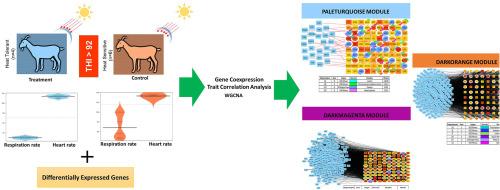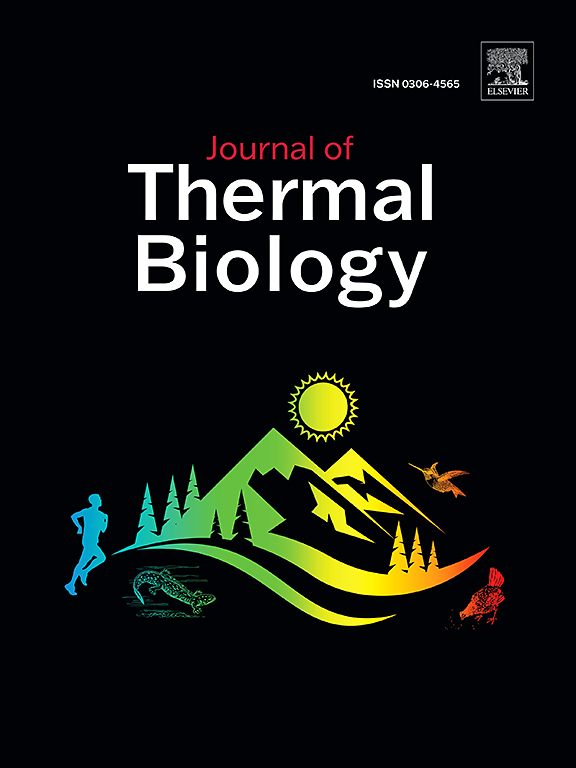Deciphering the molecular mechanisms of heat stress tolerance in goats: Insights from transcriptome and Gene Co-expression analysis
IF 2.9
2区 生物学
Q2 BIOLOGY
引用次数: 0
Abstract
Climate change poses a significant threat to the sustainability of livestock production systems in developing countries, particularly impacting small ruminants like goats, which are highly susceptible to heat stress. This stressor not only reduces productivity but also undermines economic viability. This study aimed to delve into the molecular mechanisms underlying heat stress tolerance in goats by conducting a comprehensive transcriptome analysis of heat-tolerant (HT, n = 4) and heat-susceptible (HS, n = 6) Jamunapari goats. Physiological metrics, such as rectal temperature, respiratory rate, and heart rate, were meticulously monitored under extreme environmental conditions (Temperature Humidity Index >92) to effectively classify goats based on their distinct heat stress responses. Samples of blood were obtained, and peripheral blood mononuclear cells (PBMCs) were extracted for subsequent RNA extraction. RNA-Seq analysis revealed a sum of 734 differentially expressed genes (DEGs), comprising 251 upregulated and 483 downregulated genes in HT goats compared to their HS counterparts. The WGCNA revealed three key modules, darkorange (tolerance), paleturquoise (respiration rate), and darkmagenta (heart rate). Moreover, functional enrichment analysis revealed that DEGs within these modules played intricate roles in crucial biological processes and pathways, including mitochondrial function, cardiac function, immune response, genomic stability, and metabolic regulation. This research notably enhances our comprehension of the genetic underpinnings of thermo-tolerance in goats and provides invaluable guidance for formulating breeding strategies aimed at bolstering livestock resilience against the challenges of climate change.

解密山羊耐热胁迫的分子机制:转录组和基因共表达分析的启示。
气候变化对发展中国家畜牧生产系统的可持续性构成重大威胁,尤其影响到山羊等小型反刍动物,因为它们极易受到热应激的影响。这种胁迫不仅会降低生产力,还会破坏经济可行性。本研究旨在通过对耐热山羊(HT,n = 4)和热敏感山羊(HS,n = 6)进行全面的转录组分析,深入研究山羊耐热应激的分子机制。在极端环境条件下(温湿度指数大于 92),对直肠温度、呼吸频率和心率等生理指标进行了细致监测,以便根据山羊不同的热应激反应对其进行有效分类。采集血液样本并提取外周血单核细胞(PBMCs),然后提取 RNA。RNA-Seq分析显示,与HS山羊相比,HT山羊共有734个差异表达基因(DEGs),包括251个上调基因和483个下调基因。WGCNA揭示了三个关键模块:深橙色(耐受性)、浅绿色(呼吸速率)和深品红色(心率)。此外,功能富集分析表明,这些模块中的 DEGs 在线粒体功能、心脏功能、免疫反应、基因组稳定性和代谢调控等关键生物过程和途径中发挥着复杂的作用。这项研究显著提高了我们对山羊耐热性遗传基础的理解,并为制定育种策略提供了宝贵的指导,这些育种策略旨在提高牲畜应对气候变化挑战的能力。
本文章由计算机程序翻译,如有差异,请以英文原文为准。
求助全文
约1分钟内获得全文
求助全文
来源期刊

Journal of thermal biology
生物-动物学
CiteScore
5.30
自引率
7.40%
发文量
196
审稿时长
14.5 weeks
期刊介绍:
The Journal of Thermal Biology publishes articles that advance our knowledge on the ways and mechanisms through which temperature affects man and animals. This includes studies of their responses to these effects and on the ecological consequences. Directly relevant to this theme are:
• The mechanisms of thermal limitation, heat and cold injury, and the resistance of organisms to extremes of temperature
• The mechanisms involved in acclimation, acclimatization and evolutionary adaptation to temperature
• Mechanisms underlying the patterns of hibernation, torpor, dormancy, aestivation and diapause
• Effects of temperature on reproduction and development, growth, ageing and life-span
• Studies on modelling heat transfer between organisms and their environment
• The contributions of temperature to effects of climate change on animal species and man
• Studies of conservation biology and physiology related to temperature
• Behavioural and physiological regulation of body temperature including its pathophysiology and fever
• Medical applications of hypo- and hyperthermia
Article types:
• Original articles
• Review articles
 求助内容:
求助内容: 应助结果提醒方式:
应助结果提醒方式:


